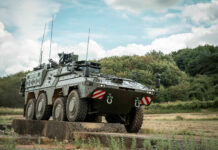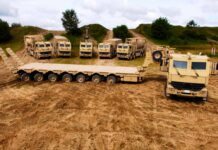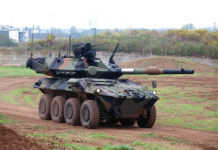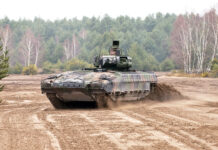Launched in 2017, the Franco-German Main Ground Combat System (MGCS) programme aims to deliver a next-generation heavy tracked platform – not simply a successor to the Leopard 2 and Leclerc main battle tanks (MBTs), but a conceptually different approach to armoured warfare. This article explores the known aspects of the MGCS programme in detail.
The timeline
Conceptualised in the early 2010s,[1] the MGCS project was formally launched in July 2017 by French President Emmanuel Macron and the then German Chancellor Angela Merkel.[2]
On 19 November 2018, Germany was announced as the lead nation in the development of the MGCS. In June 2019, Germany’s Rheinmetall joined the MGCS effort, which was initially led by the KNDS holding company, formed as a result of a merger between Krauss-Maffei Wegmann (KMW) and Nexter in 2015. Finally, in May 2020, the System Architecture Definition Study (SADS)–Part 1was awarded to Rheinmetall and KNDS.
Work on the MGCS programme was accelerated by the onset of the Russo-Ukrainian conflict. In July 2023, France and Germany agreed to develop a High-Level Common Operational Requirements Document (HLCORD) for the MGCS. This was followed by a meeting between the French and German defence ministers in September 2023, during which Boris Pistorius and Sébastien Lecornu agreed to move the MGCS project forward.
On 17 April 2025, the MGCS Project Company GmbH was established in Cologne.[3] This step will enable negotiations with the Federal Office for Equipment, Information Technology and In-Service Support of the Bundeswehr (BAAINBw) later in 2025 and allow the programme to proceed to the next phase.
Initially, the plan envisioned fielding the MGCS in the 2030s,[4] but later, the schedule was pushed back. In 2023, initial fielding and the start of serial production were expected in 2035, with full operational capability envisioned for 2040.[5] However, since then the expected fielding date has been pushed back by around 10 years from initial plans. During a press conference on 21 September 2023, Boris Pistorius said that MGCS would enter service in approximately 20 years, while Sébastien Lecornu cited the period between 2040 and 2045.[6]
By mid-2025, the total estimated cost of the programme included EUR 150 million for the SADS–Part 1, while the projected cost for SADS–Part 2 and the manufacture of technology demonstrators is expected to reach EUR 1.5 billion.[7]
The concept
Conceptually, the MGCS is a ‘system of systems’ heavily influenced by the principles of network-centric warfare and the US-developed multidomain warfare doctrine. The MGCS concept integrates modern technologies such as robotics, artificial intelligence (AI), onboard unmanned aerial vehicles (UAVs), electronic warfare (EW) systems, networked radio datalinks, and more.
On 26 April 2024, the French and German Defence Ministers, Sébastien Lecornu and Boris Pistorius, signed a memorandum of understanding (MoU) outlining the future system’s capabilities, distributed across eight technology pillars. These include: platform, traditional firepower, innovative firepower, connectivity, sensors, simulation, protection and infrastructures.[8]
![The MGCS concept consists of three vehicles: a manned MBT (top left), a manned missile carrier (front) and an unmanned sensor and NLOS weapon carrier (rear right). [Bundeswehr]](https://euro-sd.com/wp-content/uploads/2025/08/MGCS-Bundeswehr-Kopie-1024x584.jpg)
As presently conceived, MGCS is a multiplatform system that includes three tracked armoured vehicles:
- A manned MBT,
- A manned missile carrier, and
- An unmanned support vehicle equipped with sensors, UAVs, and non-line of sight (NLOS) effectors.[9]
These three vehicles will share the same base platform, which, according to the requirements, should have a weight of less than 50 tonnes. In theory, the multi-platform architecture would allow combat and support functions to be distributed among three vehicles while retaining the same level of tactical and operational mobility. At the same time, a unified platform would reduce production and maintenance costs through component commonality, simplified logistics, and allowing a degree of streamlining training.
The armament
There is still no final decision on the choice of main armament. The leading contenders are the 140 mm L48 configuration of the ASCALON gun, and Rheinmetall’s 130 mm Rh‑130 L/52 smoothbore gun, both of which would use autoloaders.
The ASCALON (Autoloaded and Scalable Outperforming gun) is a modular system featuring interchangeable 120 mm and 140 mm barrels. The remainder of the system’s components remain the same, allowing for a high level of commonality between the two versions. The ASCALON is currently undergoing trials; it was previously expected to reach technical maturity by 2025.[10] The system has already completed static stand firing tests in 2024. By the end of 2025, the system is expected to complete testing integrated into an actual tank turret.
In the meantime, Rheinmetall offers a 130 mm gun with a more traditional design. The advantages of this system lie in its technical maturity and the well-established manufacturing process. Although Rheinmetall’s 130 mm gun is considered unlikely to be selected for MGCS, it may still prove valuable for ‘intermediate MBT solutions’, representing an advancement over current 120 mm tank guns.
Comparing these two systems, the ASCALON appears to be the preferred option, strongly advocated by its developer KNDS France. Its main advantages lie in its significant potential for future development, both in terms of the gun system and ammunition, as well as its flexibility to be used in 120 mm or 140 mm, which allows it to be adapted to a wide range of end-user requirements.
![The ASCALON gun was showcased in both 140 mm (left) and 120 mm (right) configurations at the Eurosatory 2024 exhibition. [Tank Encyclopedia courtesy photo]](https://euro-sd.com/wp-content/uploads/2025/08/ascalon_120_140-Kopie-1024x768.jpg)
Secondary armaments of the MGCS platforms are slated to include a wide range of offensive and defensive systems, such as a hypersonic effector, and NLOS effectors to provide an indirect fire capability. Other weapons will likely include machine guns and automatic cannons, either mounted in remote weapon stations (RWSs) or coaxially, for the counter-UAV (C-UAV) role or engaging soft targets. A possible directed energy weapon (DEW) has also been discussed in prior years, but more recent presentations have omitted it.
Employment
At the moment, the concept of operations (CONOPS) for the MGCS has only been outlined broadly; however, the available information provides some understanding of how the three-vehicle system is likely to operate.
According to information from the IAV 2025 event, MGCS will focus on two key aspects – mobility and SDRI+T (surveillance, detection, recognition and identification plus targeting). These will be complemented with more traditional aspects of the ‘iron triangle’, such as firepower in form of vast array of direct and indirect effectors, and a sophisticated protection suite. In the latter case, each AFV within the group will include passive armour, a hard-kill active protection systems (APS) and electronic warfare (EW) systems. However, a collective defence system, where each AFV protects the others, is also possible.
One possible solution for the APS is the modular hard-kill Diamant system by Thales Group. Diamant is being developed under the French Ministry of Defence’s (MoD’s) PROMETEUS programme for integration with the vehicle being procured under the SCORPION programme. The system consists of radar sensors and multiple replaceable effector modules. Each module contains two effectors: one upward-firing (for top-attack or high-angle threats) and one downward-firing (for direct-fire threats), enabling it to counter a wide array of threats.
The focus on sensors and mobility is based on observations of modern land warfare, as well as an understanding of battlefield conditions and the array of future threats. Today’s battlefield is characterised by several important factors: an increased density of enemy ISR assets; a surge in the use of precision-guided munitions at the tactical level; and a new array of threats to AFVs and their combinations.
![A mock-up of Thales’ Diamant hard-kill APS was shown on the EMBT-ADT 140 prototype shown at Eurosatory 2024. It is shown here as a black strip of effector modules running along the top of the turret, with radars at the turret corners. [Mark Cazalet]](https://euro-sd.com/wp-content/uploads/2025/08/Diamant_Mark-Cazalet-Kopie-1024x683.jpg)
This task, however, presents a challenge: the amount of data received by the system must not overwhelm the crews. From the perspective of Hensoldt, the solution lies in greater automation. Information gathered from various sensors – including optronics, radars, UAVs, and allied assets – will be consolidated and analysed with the support of artificial intelligence (AI) in real time. The results will be shared across MGCS vehicles within a group, and likely with higher echelons of allied command as well.[11] At least in theory, this will reduce the burden on the crews while providing them with a comprehensive picture of the battlefield.
Notionally, all three vehicles are intended to operate as a single unit. However, combat scenarios in which one or more vehicles in the group are damaged or immobilised are likely. Therefore, it is reasonable to assume that MGCS vehicles will also be capable of operating individually or in smaller groupings, albeit with reduced capabilities.
Of course, many questions remain unanswered. What will the composition of an MGCS armoured unit look like? How will the MGCS, with its vast and diverse arsenal, be resupplied in the field? Will there be organic engineering capabilities for any of the AFVs, or an indirect fire capability for the main gun? How far apart can MGCS vehicles in a group disperse while retaining connectivity? While many of these remain the subject of speculation, the further the MGCS programme progresses, the more specific details will emerge.
Intermediate solutions
While initially understood as a replacement for the Leopard 2 and Leclerc MBTs, in April 2024 the German and French Ministers of Defence reiterated that MGCS is not intended to be a direct successor to today’s Leopard 2 or Leclerc. “It’s not about the tank of the future, but about the future of the tank,” they said.[12]
This position is understandable, given the complexity of the MGCS programme, its development timeline, and the history of delays. Until the MGCS is ready, at least for initial fielding in the 2040s, an ‘interim solution’ will be required.
This will most likely result in Germany upgrading the majority of their MBT fleet to the Leopard 2A7/2A8 standards, and France to Leclerc XLR variants, to fill the capability gap. If the MGCS programme proceeds according to schedule, in the 2040s both nations would operate fleets consisting of legacy systems, possibly with further upgrades, alongside smaller numbers of newer and more sophisticated MGCS platforms.
![The Leclerc XLR MBT on display at Eurosatory 2024. The XLR features improved protection over earlier Leclerc family variants. [Mark Cazalet]](https://euro-sd.com/wp-content/uploads/2025/08/Leclerc-XLR_Mark-Cazalet-Kopie-1024x683.jpg)
Closing thoughts
It is worth noting that despite the progress being made, attitudes toward the MGCS programme remain sceptical. Supporting this view, many observers point to the programme’s complexity, disagreements among stakeholders, and the repeatedly shifting project schedule. Further confusion and even uncertainty are caused by the overwhelming number of tank-related programmes across Europe, which are at various stages of development.
Beyond the MGCS programme, other ongoing efforts include upgrades to the Leopard 2 and Leclerc, the KF51 Panther by Rheinmetall (currently marketed to Hungary and Italy),[13] and a German-led joint battle tank development programme involving KMW and Rheinmetall on one side and Italy, Sweden, and Spain on the other.[14] There is also the Leopard 2AX (also known as the Leopard 3 and ‘Brückenlösung’), a synthesis of the Leopard 2A8 and Rheinmetall’s KF51. Announced in September 2023, this programme may serve as a ‘bridge solution’ for the Bundeswehr until the MGCS arrives.[15] [16] Finally, there is the European MARTE (Main Armoured Tank of Europe) initiative. Launched in July 2025, it aims “to conduct study and design activities to create a future MBT system that adequately meets current and future threats, as well as the harmonised needs of the European Member States involved.”[17]
| Programme/Model | Status/Timeline |
| MGCS | Entry into service expected around 2040-2045. |
| Leopard 2A7 | In production, deliveries ongoing. |
| Leopard 2A8 | In production, deliveries began in 2025.[18] |
| Leopard 3/2AX | Technical studies ongoing, operational deployment expected by 2030.[19] |
| Leclerc XLR | In production, at least 34 delivered in 2024-2025.[20] |
| KF-51 | In development, serial production is expected to begin in 2025.[21] |
| MARTE | Research programme, further timeline is unknown. |
While it is impossible at this point to predict the future of these programmes even in the short term, it is possible to draw some conclusions about the future shape of the European MBT and AFV landscape.
First, the sheer number of MBT programmes indicates a growing interest in improving conventional armoured capabilities across European nations, as part of a global trend. Many nations are seeking solutions to upgrade their existing AFV fleets, and even expand them. There is a well-established consensus that the tank is not dead, and the AFV market is responding accordingly.
![The Leopard 2A8 on display at Eurosatory 2024. This variant introduces the Trophy hard-kill APS. [Mark Cazalet]](https://euro-sd.com/wp-content/uploads/2025/08/Leopard-2A8_Mark-Cazalet-Kopie-1024x683.jpg)
Third, the MGCS programme has no true alternatives within Europe or internationally, and no single European nation currently possesses the technological or industrial capacity to develop a next-generation MBT independently. A hypothetical scenario in which a non-European producer develops a next-generation MBT and secures European customers, all within the same timeframe as the MGCS, would represent a significant decline in strategic relevance for Europe’s armoured vehicle industry. In other words, given the time pressure, abandoning MGCS would likely spell the end of any future MBT ambitions in Europe for the foreseeable future. In addition, such a decision could have long-term negative consequences, including the potential loss of international market share to competitors.
Regarding delays in the MGCS programme, it is important to note that they may ultimately prove beneficial. While many tactical and technological aspects of modern and future warfare were envisioned in the 2010s, a comprehensive understanding of the battlefield environment and the full spectrum of threats to AFVs has only emerged in recent years. A slower pace in developing requirements and refining CONOPS could prove advantageous for the MGCS programme as a whole, as well as for its future operators.
Despite recent progress, the MGCS programme still faces substantial risks, primarily political in nature. Differing national priorities, industrial interests, and shifting strategic outlooks continue to pose challenges to its development. Another critical issue is the question of industrial scalability: Can the European defence industry simultaneously deliver the MGCS programme, interim solutions for domestic operators, and fill the growing demand for MBTs internationally?
What is clear, however, is that Europe possesses both the technological expertise and financial resources necessary to complete the MGCS programme. Moreover, there is currently no viable alternative that could match the ambitions or strategic value of the programme. In this context, the MGCS programme is not just a question of military capability, but of preserving Europe’s strategic autonomy and industrial competitiveness in the armoured warfare domain.
![A T-14 MBT at the Armiya-2024 exhibition. Thus far, T-14 is the only next-generation MBT accepted into service, albeit in very limited numbers. [Alexey Tarasov]](https://euro-sd.com/wp-content/uploads/2025/08/T-14_army-2024_2-Kopie-1024x576.jpg)
Alexey Tarasov
Author: Alexey Tarasov is a land warfare expert specialising in Europe, Russia, and armoured vehicles. He has contributed to ESD, Shephard News, along with other publications, and has authored several books.
[1] Preparations started in 2012
[2] Troubled Twins: The FCAS and MGCS Weapon Systems and Franco-German Co-operation. Johanna MÖHRING – https://www.ifri.org/en/studies/troubled-twins-fcas-and-mgcs-weapon-systems-and-franco-german-co-operation
[3] https://www.rheinmetall.com/en/media/news-watch/news/2025/04/2025-04-17-mgcs-project-company-gmbh-established-in-cologne
[4] RHEINMETALL AG 2015. CAPITAL MARKETS DAY. ARMIN PAPPERGER. NOVEMBER 26, 2015
[5] Main Ground Combat System (MGCS): A Status Report. Sidney E. Dean. 23. January 2023 – https://euro-sd.com/2023/01/articles/29122/main-ground-combat-system-mgcs-a-status-report/
[6] MGCS: Timetable for future main battle tank system significantly extended. September 26, 2023 – https://esut.de/en/2023/09/meldungen/44630/mgcs-zeitplan-fuer-zukuenftiges-kampfpanzersystem-deutlich-verlaengert/
[7] M. Chassilan, “MGCS, ménage à trois or more, EDR Magazine, No. 63, June 2022
[8] If MGCS drags out, Rheinmetall pitches Concept Unmanned Turret as near-term alternative. Tim Martin and Ashley Roque. on June 17, 2024 – https://breakingdefense.com/2024/06/if-mgcs-drags-out-rheinmetall-pitches-concept-unmanned-turret-as-near-term-alternative/
[9] IAV 2025: multi-platform MGCS continues on its path undeterred. Gerhard Heiming. 24. January 2025 – https://euro-sd.com/2025/01/major-news/42246/mgcs-continues-on-its-path/
[10] ASCALON Proposed for MGCS. Gerhard Heiming 16. April 2021 – https://euro-sd.com/2021/04/articles/exclusive/22363/france-proposes-mgcs-weapon
[11] MGCS – Main Ground Combat System. HENSOLDT website, accessed in July 2025 https://www.hensoldt.net/programs/smart-tank-rolling-in
[12] MoU signed for MGCS with eight technology pillars. Gerhard Heiming. April 26, 2024 – https://esut.de/en/2024/04/meldungen/49165/mou-fuer-mgcs-mit-acht-technologiesaeulen-unterzeichnet/
[13] Italy to buy up to 380 new tanks and over 1,000 infantry fighting vehicles. January 26, 2025 – https://defence-industry.eu/italy-to-buy-up-to-380-new-tanks-and-over-1000-infantry-fighting-vehicles/
[14] So startet Deutschland eine neue Kampfpanzer-Allianz. 11.09.2023 – https://www.handelsblatt.com/politik/international/leopard-2-nachfolger-so-startet-deutschland-eine-neue-kampfpanzer-allianz/29374860.html
[15] Bundeswehr beauftragt Entwicklung von 130mm-Munition sowie neuem Schutzsystem und Triebwerk für Leopard-2-Kampfpanzer. Waldemar Geiger. 5. Februar 2025 – https://www.hartpunkt.de/bundeswehr-beauftrag-entwicklung-von-130mm-munition-sowie-neuem-schutzsystem-und-triebwerk-fuer-leopard-2-kampfpanzer/
[16] Troubled Twins: The FCAS and MGCS Weapon Systems and Franco-German Co-operation. Johanna MÖHRING – https://www.ifri.org/en/studies/troubled-twins-fcas-and-mgcs-weapon-systems-and-franco-german-co-operation
[17] Press-Release. MARTE ARGE – Main Armoured Tank of Europe. 1 July 2025 – https://www.rheinmetall.com/en/media/news-watch/news/2025/07/2025-07-01-marte-main-armoured-tank-of-europe
[18] https://breakingdefense.com/2023/05/germany-buys-18-leopard-2a8-main-battle-tanks-to-replace-those-sent-to-ukraine
[19] https://www.czdefence.eu/article/the-first-leopard-3-tanks-will-enter-service-in-2030-will-they-get-a-chance-in-the-czech-army
[20] https://www.defensemagazine.com/article/the-first-french-armys-tactical-group-to-receive-51-leclerc-xlr-tanks-by-the-end-of-2025
[21] Rheinmetall will be ready for serial production of KF 51 Panther in 15-18 months. March 15, 2023 – https://defence-industry.eu/rheinmetall-will-be-ready-for-serial-production-of-kf-51-panther-in-15-18-months/


![The KNDS EMBT-ADT 140 technology demonstrator on display at the Eurosatory 2024 exhibition. This model featured the 140 mm configuration of the ASCALON gun. [Mark Cazalet]](https://euro-sd.com/wp-content/uploads/2025/08/EMBT-EDT-140_Mark-Cazalet-Kopie.jpg)


![What next for Abrams? A US Army M1A2 Abrams main battle tank (MBT) from Comanche Company, 4th Battalion, 6th Infantry Regiment moves to a refuelling point during Exercise Talisman Sabre 23 at the Townsville Field Training Area, Townsville, Australia, 25 July 2023. [US Army/Spc Charlie Duke]](https://euro-sd.com/wp-content/uploads/2025/09/original-Kopie-218x150.jpg)
![Russian industry continues development of key land warfare systems The T-90M MBT equipped with Arena-M APS, during trials. [UVZ]](https://euro-sd.com/wp-content/uploads/2025/07/T-90-with-Arena-M-218x150.jpg)






